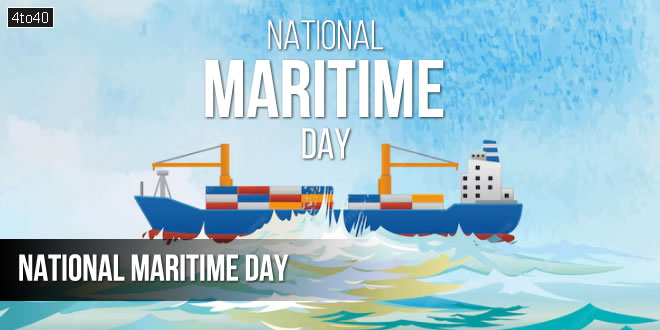India celebrates its National Maritime Day on April 5th. This day commemorates the inaugural voyage of the SS Loyalty, the first Indian-owned ship, from Mumbai to London in 1919.
National Maritime Day: 05 April
April 5th is a vital day on the Indian calendar, marking the celebration of National Maritime Day. This annual observance holds profound importance as it commemorates a pivotal moment in our maritime history – the inaugural voyage of the “SS Loyalty” in 1919, a voyage that echoes our journey toward becoming an independent maritime nation.
India’s maritime heritage extends beyond historical milestones; it plays a crucial role in our contemporary success story. Today, India stands proudly as one of the leading economies globally, and a significant part of this stature is attributed to the thriving trade sector and a robust shipping industry.
As we reflect on National Maritime Day, it’s imperative to recognise the indispensable contribution of the maritime sector to our nation’s economic prosperity. India’s inclusion into the global economy has been significantly facilitated by its expansive coastline and the strategic location of its ports. The maritime industry is a linchpin for international trade, seamlessly connecting our shores to distant lands. Importing and exporting goods via ships have become the lifeblood of our economy, fostering economic growth, creating job opportunities, and enhancing our global standing.
Behind the scenes of this economic juggernaut are the unsung heroes of the seas—the dedicated crews who embark on maritime journeys that span months on end. These seafarers make an incredible sacrifice, enduring the challenges of the high seas, away from their families, to ensure the smooth sailing of our shipping industry. Their resilience, diligence, and commitment form the backbone of this sector, and National Maritime Day serves as a poignant reminder to honour their invaluable contribution.
The Maritime Sector in India: An Overview
The Indian Maritime sector, which encompasses ports, inland water transport, and ship recycling, holds a significant position globally. In terms of shipbuilding, India ranks 21st globally, and when it comes to supplying trained manpower in the maritime sector, India stands at the 5th position.
Ports in India:
- India is home to 12 major ports.
- In addition to the major ones, there are over 200 non-major ports in India.
- The Maritime Sector is responsible for handling 65% of India’s trade value.
- A whopping 95% of India’s trade volume is managed through the Maritime sector.
- Of the total cargo handled at ports in India, 54% of cargo is managed by the 12 major ports.
- In the global ranking of top 40 container ports, Jawaharlal Nehru Port Trust (JNPT) and Mundra hold the 33rd and 37th positions, respectively.
Inland Water Transport in India
- Over the past few years, Inland Water Transport in India has seen considerable growth.
- Currently, over 5,000 km of navigable inland waterways are under development in India.
Ship Recycling in India
- In the global ranking for ship recycling, India holds the 2nd position.
Maritime India Vision – 2030
To ensure a leading position in the global maritime sector, the Maritime India Vision 2030 has outlined 10 Key themes . These themes are as follows:
- Enhance Global Share in Ship Building, Repair, and Recycling
- Strengthen Policy and Institutional Framework to Support all Stakeholders
- Enhance Logistics Efficiency through Technology and Innovation
- Drive E2E Logistics Efficiency and Cost Competitiveness
- Develop best-in-class Port infrastructure
- Lead the World in Safe, Sustainable & Green Maritime Sector
- Become Top Seafaring Nation with World-Class Education, Research & Training
- Enhance India’s Global stature and Maritime Cooperation
- Promote Ocean, Coastal and River Cruise Sector
- Enhance Cargo and Passenger Movement through Inland Waterways
Sagarmala Programme: An Initiative by the Government of India
On 25th March 2015, the Union Cabinet approved the concept of the Sagarmala. Subsequently, on 14th April 2016, the Prime Minister of India unveiled a National Perspective Plan (as part of Sagarmala) for the comprehensive development of India’s potential 14,500 km of navigable waterways and 7,500 km coastline, at the Maritime India Summit 2016.
Sagarmala Programme: Key Components
- Coastal Shipping & Inland Waterways Transport
- Coastal Community Development
- Port-linked Industrialization
- Port Connectivity Enhancement
- Port Modernization & New Port Development
Sagarmala Programme: Objectives and Concept
- By developing port proximate discrete manufacturing clusters, it aims to improve export competitiveness.
- It seeks to lower the logistics cost of bulk commodities by locating future industrial capacities near the coast.
- It aims to reduce the cost of transporting domestic cargo through optimizing the modal mix.
National Maritime Day: History
Reflecting on the maiden voyage of the “SS Loyalty” in 1919, we recognise that this historic journey was more than just a ship setting sail; it symbolised India’s stubborn determination to break free from the shackles of dependency and forge its path as a maritime powerhouse. The “SS Loyalty”, proudly owned by the Scindia Steam Navigation Company, emerged as a pioneering vessel that would chart the course for India’s maritime independence.
The Scindia Steam Navigation Company, founded by the visionary Walchand Hirachand Scindia, was pivotal in shaping India’s maritime destiny. Established in the early 20th century, it symbolised indigenous maritime entrepreneurship. It marked a significant departure from the era of foreign-owned ships dominating our waters.
The Scindia Steam Navigation Company’s ownership of the “SS Loyalty” carried profound symbolism. It manifested the belief that our maritime destiny should be in our hands, steering our ship towards progress and self-reliance. The entrepreneurial spirit of the Scindia Steam Navigation Company laid the foundation for a vibrant Indian shipping industry, fostering a sense of pride and ownership in our maritime endeavours.
Today, as we navigate the waters of progress, we owe a debt of gratitude to those early pioneers and the modern-day seafarers who continue to propel us forward. The legacy of the “SS Loyalty” and the Scindia Steam Navigation Company stands as a testament to the resilience and determination that define India’s maritime narrative. It inspires the current generation, reinforcing that we can overcome challenges and sail towards a brighter, self-sufficient maritime future with perseverance, innovation, and a sense of ownership.
In commemorating National Maritime Day, we celebrate the historic voyage of the “SS Loyalty” and pay homage to the visionary leaders and dedicated seafarers who have contributed to developing our maritime identity. The journey from dependence to independence was charted by ships like the “SS Loyalty,” guided by the principles of self-determination and the belief that India could navigate its course on the global maritime stage.
National Maritime Day bridges our maritime past and present, highlighting the journey from dependence to independence and emphasising the maritime sector’s instrumental role in our nation’s contemporary success. As we celebrate this day, let’s honour our rich maritime legacy and express gratitude to the dedicated individuals who, through their sacrifices, contribute to India’s prominence on the global economic stage.
National Maritime Day: Theme
- 2025: Our Ocean, Our Obligation, Our Opportunity
- 2024: Navigating the Future: Safety First!
- 2023: Amrit Kaal in Shipping
- 2022: Sustainable Shipping beyond Covid-19
- 2021: Sustainable Shipping beyond Covid-19
- 2020: Sustainable Shipping beyond Covid-19
- 2019: Indian Ocean – An Ocean of opportunity
National Maritime Day 2023 is being celebrated on the theme ‘Amrit Kaal in Shipping‘ this year. The 60th anniversary of the event is centred on giving thanks to the men who spend countless months at sea, conducting the majority of India’s trade and commerce on a global scale.
The theme of the 59th edition of the National Maritime Day 2022 is “Sustainable Shipping beyond Covid-19”
The theme of the 56th edition of the National Maritime Day 2019 celebrations was “Indian Ocean-An Ocean of opportunity“. This day is celebrated to support the global economy, the most well-organized, safe and sound environmentally responsive approach to transporting goods from one corner to another corner of the world.
National Maritime Day: Celebration
National Maritime Day in India is not merely a day of reflection but also a time for vibrant celebrations and initiatives to raise awareness about the maritime sector’s significance. Various events and activities can be organised to involve the public and inspire the younger generation, creating an environment of enthusiasm and learning.
1. Maritime Exhibitions:
Hosting maritime exhibitions can provide an interactive platform for showcasing the evolution of the maritime industry. Displaying models of ships, navigational instruments, and technological advancements can captivate the audience and offer insights into the sector’s rich history and modern innovations.
2. Career Guidance Workshops:
Organising workshops focusing on maritime industry career opportunities can benefit students. Experts and professionals from various maritime fields can share their experiences, shedding light on the diverse career paths available, from navigation and engineering to logistics and management.
3. Interactive Maritime Simulations:
Setting up maritime simulations can offer a hands-on experience. Participants can virtually navigate ships, understand the challenges faced at sea, and gain a deeper appreciation for the skills required in maritime professions. Using interactive methods can make learning more interesting and easier to remember.
4. Educational Webinars:
Leveraging the power of technology, webinars can be organised to reach a broader audience. Experts can discuss topics such as sustainable shipping practices, the impact of maritime activities on the environment, and technology’s role in shaping the industry’s future. Webinars allow real-time interaction, enabling participants to ask questions and engage in discussions.
5. Maritime Heritage Tours:
Guided tours of maritime heritage sites, such as shipyards, historical ports, or maritime museums, can provide a tangible connection to the industry’s roots. Understanding shipbuilding evolution and maritime pioneers’ contributions can instil pride and appreciation for this vital sector.
6. Art and Essay Competitions:
Encouraging creativity and expression, art and essay competitions centred around maritime themes can be organised in schools and colleges. This fosters artistic talents and allows participants to delve deeper into the historical and contemporary aspects of the maritime industry.
7. Community Outreach Programs:
Community outreach programs can be organised to engage residents by extending the celebrations beyond academic institutions. These may include talks, demonstrations, or interactive sessions in community centres, emphasising the maritime sectors impact on everyday life.
By incorporating a mix of these events and activities, National Maritime Day can evolve into a dynamic celebration that honours the past and cultivates a deep understanding and appreciation for the maritime industry among people of all ages.
Facebook Covers, Banners & Posters:
FAQs
1. What is National Maritime Day in India?
National Maritime Day is observed on April 5th every year to commemorate the maiden voyage of the SS Loyalty, marking the beginning of India’s modern maritime history.
2. Why is National Maritime Day celebrated?
It celebrates India’s maritime heritage and recognises the importance of the maritime sector in the country’s history, economy, and development.
3. How did the tradition of celebrating National Maritime Day start?
The day was first celebrated in 1964 to honour the SS Loyalty’s historic journey and to create awareness about the significance of the maritime industry.
4. What role does the maritime sector play in India’s economy today?
The maritime sector is crucial to India’s economy, facilitating trade, commerce, and connectivity. It manages a considerable share of the nation’s imports and exports.
5. What events are typically organised on National Maritime Day?
Events include seminars, exhibitions, workshops, and awareness campaigns organised by government bodies, maritime organisations, and educational institutions.
6. How can the public participate in National Maritime Day celebrations?
Individuals can attend local events, engage in educational activities, and support maritime initiatives. Social media platforms often feature campaigns and hashtags related to the day.
7. What are some notable achievements in India’s maritime history?
India has a rich maritime history, with achievements such as ancient navigation skills, trade routes, and contributions to global maritime exploration.
8. What challenges does the Indian maritime industry face today?
Challenges include infrastructure development, environmental concerns, and the need for a skilled workforce. Policy changes and technological advancements are being made to address these challenges.
9. How can students pursue a career in the maritime industry?
Students can enrol in maritime education institutions that offer courses in navigation, marine engineering, and related fields. They can also explore various career paths, including shipping, logistics, and naval architecture.
10. What government initiatives support the growth of the maritime sector in India?
Initiatives like ‘Sagarmala‘ and ‘Make in India‘ aim to promote port-led development, infrastructure enhancement, and investment in the maritime sector. These initiatives play a vital role in the growth and sustainability of the industry.
 Kids Portal For Parents India Kids Network
Kids Portal For Parents India Kids Network










